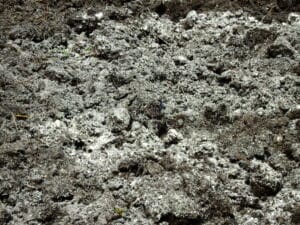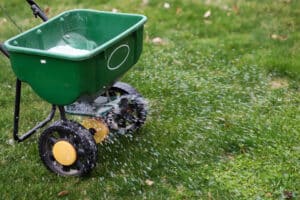Fescue is a cool-season grass known for its ability to withstand heat, cold, and drought. It’s a popular choice for northern lawns but also thrives in regions with both warm and cool seasons.
With deep roots that efficiently absorb nutrients, fescue requires less water and fertilizer than many other cool-season grasses. Below, we’ll explore the most common types of fescue and compare their benefits to help you decide if fescue is the right fit for your lawn.
Get a Quote From Lawn Professionals Near You
Get a quote in as little as 5 minutes
Clicking “Get Your Estimate” submits your data to Home Service Quotes, which will process your data in accordance with the Home Service Quotes Privacy Policy.

Lime Soil Amendment

Lawn Fertilization
Pros and Cons of Fescue Grass
As with any turfgrass or ground cover, fescue grass offers benefits and drawbacks compared to other options. Fescue grass is generally one of the most popular lawn choices in the U.S. because of the following benefits, but it’s also important to consider the downsides when choosing the right option for your home.
Pros
- Requires little to no winter maintenance by staying green longer in cooler months
- Withstands heavy wear and tear, which is ideal for high-traffic areas
- Doesn’t require extensive dethatching unlike some other turfgrasses
- Drought-resistant with deep roots that allow survival with less frequent watering compared to other cool-season grasses
- Grows and performs better in partially shaded areas than many other turfgrass varieties
Cons
- Susceptible to brown patches during hot and humid summer months without proper care
- May require overseeding during summer months since thinning can occur
- Slower to recover from damage compared to warm-season grasses
- Prone to disease in wet conditions as excess moisture can lead to fungal diseases like red thread or dollar spot
Types of Fescue
Fescue grass is a genus consisting of hundreds of seed varieties. However, the most common species used in yards include tall fescues and fine fescues.



Tall Fescue Grass
Tall fescue is a low-maintenance grass with a signature bunch-forming growth pattern that rarely requires dethatching. Many tall fescue lawns are Kentucky 31 fescue, a subtype that’s known for its coarse appearance. Tall fescue grass is used in high-traffic areas like baseball fields and commercial sites because it’s durable and shade-tolerant. This type of fescue has a deep root system that allows it to tolerate periods of no rain.
Fine Fescue Grass
Fine fescues have narrower, finer blades than tall fescues, and they are slightly less tolerant of wear and tear than tall fescue. However, they make up for it with superior drought tolerance and low need for fertilization. A blend of fine fescue seeds is sometimes used to create a low-mow lawn. The most common cultivars used in lawns are creeping red fescue, hard fescue, chewings fescue, and sheep fescue.
Creeping Red Fescue Grass
Creeping red fescue comes in slender and strong varietals, both of which tolerate low mowing height and resist weed growth very well. Often, creeping red fescue is mixed with other grass seeds to promote shade tolerance and reduce fertilization needs.
Hard Fescue Grass
Hard fescue is used in grass seed blends to decrease erosion and increase drought resistance. This fescue variant is most commonly used in golf course roughs and other sports turfs due to its low maintenance needs.
Chewings Fescue Grass
Chewings fescue is similar to tall fescue in that it grows in an upright fashion, but it has finer, thinner leaves. This type of fescue does well in the northern United States and Canada, and it is known for its drought resistance.
Sheep Fescue Grass
Sheep fescue grass improves soil conditions and is used to curtail erosion. It has a distinctive blue-green color and is very similar in characteristics to hard fescue.
Growing Your Fescue Grass
Although fescue lawns don’t require heavy maintenance, there are a few simple tasks you’ll need to complete in order to grow a healthy, full fescue lawn:
Step 1: Mowing
- Wait a few weeks after planting grass seed before mowing to allow seeds to mature.
- Once established, mow when the grass reaches about 4 inches, trimming no more than one-third of the blade length at a time.
- Avoid mowing during extreme drought or high summer heat, as this can stress the grass.
Step 2: Weeding
- Fescue’s thick blades naturally block weeds in the cooler months, but thinning grass in summer can allow weeds to take hold.
- Regularly remove weeds by hand or use a targeted weed treatment if needed.
- Keep the grass slightly taller and apply slow-release fertilizer to discourage weed growth.
Step 3: Watering
- Although fescue is drought-resistant, it requires extra water during hot summer months.
- Water deeply but infrequently, soaking the top few inches of soil, then wait until the grass begins to wilt before watering again.
- Adjust watering based on your lawn’s specific needs and local climate conditions.
Step 4: Aerating
- The best time to aerate your lawn is during fall or spring, when fescue is actively growing.
- Use a core aerator to break up compacted soil and improve air, water, and nutrient absorption.
- After aerating, apply fertilizer to help nutrients reach the roots and support healthy growth.
It takes most fescue seeds 14–21 days to germinate and show signs of growth, though fine fescue tends to grow a bit quicker than tall fescue. Many factors affect the germination period, including the temperature, your soil’s oxygen level, and its watering schedule. Be patient with your fescue lawn, as it might require overseeding and a proper mowing for you to see a full, healthy lawn.
Using Professional Lawn Care Services
Hiring a lawn care professional is the ideal way to achieve a lush and healthy fescue lawn. With the expertise and skills of a lawn care provider, you can ensure that your lawn’s maintenance is handled, giving you a beautiful, green yard without the hassle. Investing in the tools, nutrients, and products required to care for your lawn can become costly, often making the best lawn care services a cost-effective option in the long run.
Best Lawn Care Company: TruGreen
With a variety of annual programs, a la carte services, and organic options, TruGreen is our recommended lawn care provider. The company provides each customer with a satisfaction guarantee and offers a mobile app for instant customer service. Additionally, the company offers pest control services in select locations.
FAQs About Fescue Grass
What is the best fertilizer for fescue grass?
The best fertilizer for fescue is high-nitrogen, low-phosphorus fertilizer applied in the late fall or early spring is ideal for most fescue varieties. It’s best to use a slow-releasing fertilizer to ensure your grass receives necessary nutrients over the course of a few months.
What does overwatered grass look like?
There are a few signs to look for when you suspect you’ve overwatered your lawn:
- Spongy ground
- Excessive weeds, thatch, or bugs
- Yellow grass
- Water runoff
- Fungus growth
When is the best time to water fescue grass?
The best time to water fescue, and most grass types, is early in the morning. This prevents excessive evaporation while ensuring that your yard doesn’t stay wet for too long.
Our Rating Methodology
We back up our lawn recommendations with a detailed rating methodology that we used to objectively score each provider. We reviewed lawn care plans and packages, navigated provider websites and spoke with customer service representatives, requested quotes, and analyzed customer reviews for each provider. We then scored providers against our review standards for plan options, additional benefits and customizability, availability, trustworthiness, and customer service to arrive at a final score out of 5 stars.






